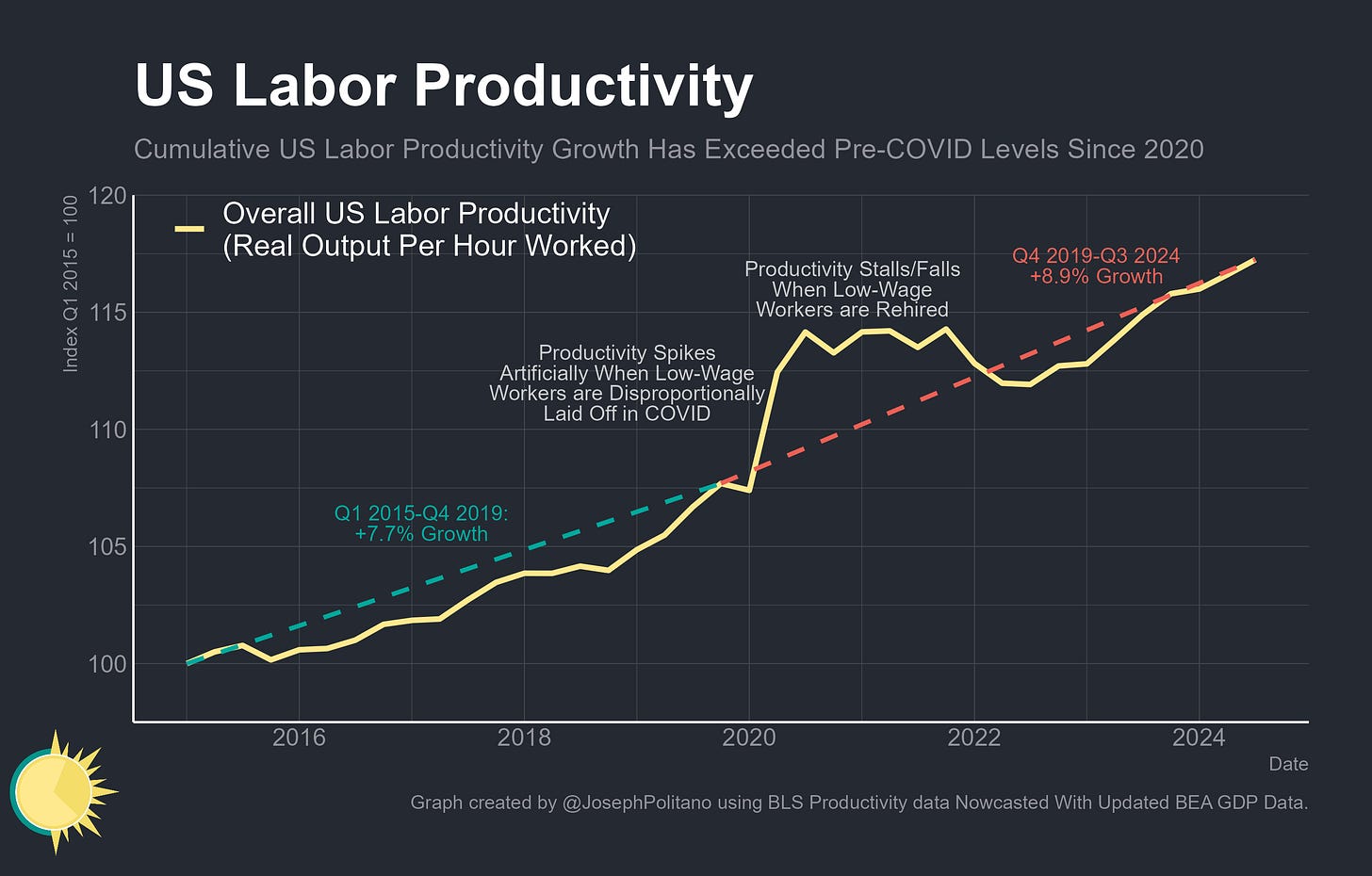The Sunday Drive - 12/08/2024 Edition [#140]
Musings and Meanderings of a Financial Provocateur
👋🏼 Hello friends,
Greetings from Saratoga Spring, NY! 🐎 Let’s enjoy a leisurely Sunday Drive around the Internet.
🎶 Vibin'
It’s been quite a while since we vibed to a movie mashup video. I recently ran across this awesome gem and thought it was worth sharing. Enjoy.
💭 Quote of the Week
“More fiction has been written in Excel than in Word.“
— Morgan Housel
📈 Charts of the Week
America’s Productivity Boom: What It Means and Why It Matters
Over the years, there’s been a lot of talk about productivity—how we measure it, what drives it, and why it matters. The U.S. has been on a roll lately, with labor productivity (how much output we get per hour of work) growing faster than it has in years. When you stack up the U.S. against other advanced economies, the difference is striking. So what’s going on here, and what does it mean for the economy moving forward? Let’s dig in.
The Big Picture: A Post-Pandemic Productivity Surge
Take a look at the first Chart. It tracks U.S. labor productivity growth since 2015. Before the pandemic, things were steady—about 7.7% cumulative growth from Q1 2015 to Q4 2019. Then came COVID, and everything got weird.
During the early days of the pandemic, a lot of low-wage workers—think restaurant servers, retail clerks—lost their jobs. Since these workers tend to have lower productivity, the math made it look like productivity was skyrocketing. Of course, that wasn’t real growth; it was just a statistical quirk. Once the economy reopened and those workers came back, productivity normalized. But what’s interesting is what happened next: productivity didn’t just go back to the old trend—it accelerated.
Between Q4 2019 and Q3 2024, productivity grew 8.9%. That’s significantly faster than what we were seeing before COVID. Why?
A few reasons:
Businesses leaned hard into digital tools and automation during the pandemic, and those investments are paying off.
With tight labor markets and rising wages, companies are looking for ways to do more with less—driving innovation.
The shift to remote and hybrid work in certain industries has improved efficiency in surprising ways.
The U.S. vs. The Rest of the World
The second Chart compares U.S. productivity growth to other developed economies. And here’s the headline: the U.S. is pulling away. By 2024, U.S. labor productivity is nearly 20% higher than in 2015. Other advanced economies, like Germany, Japan, and the UK? They’re barely hitting 5–10% growth over the same period.
What’s driving this gap? A few things stand out:
Technology Leadership: The U.S. has been quicker to adopt cutting-edge tools like artificial intelligence and automation. This tech revolution is boosting productivity across industries, from logistics to finance.
Labor Market Flexibility: U.S. businesses tend to adapt faster to economic shocks, reallocating resources and embracing new ways of working.
Capital Investment: American firms have been pouring money into tech and infrastructure, creating a foundation for sustained productivity gains.
Meanwhile, other countries face bigger headwinds. Europe struggles with rigid labor markets, and Japan has long been dealing with an aging population and slower technological adoption. Even Canada and Australia, which share some similarities with the U.S., haven’t been able to match its productivity momentum.
Demographics: Friend or Foe?
One wildcard in the productivity story is demographics. An aging workforce could slow things down—older workers are generally less productive, and they’re often slower to adopt new technologies. But in the U.S., this hasn’t been as big of an issue. Why?
Investments in automation are helping older workers stay productive longer.
Immigration and higher birth rates mean the U.S. has a healthier pipeline of younger workers compared to, say, Japan or Italy.
That said, labor shortages—whether they’re driven by demographics or other factors—are forcing companies to innovate. Think of all the robots you see in warehouses or how AI is transforming customer service. Necessity really is the mother of invention.
Looking Ahead: What’s Next for U.S. Productivity?
So, where do we go from here? The U.S. seems well-positioned to keep the productivity party going. Emerging technologies like targeted generative AI (think specialized ChatGPT for specific industries) are poised to unlock new levels of efficiency. Add in federal investments in infrastructure and manufacturing, and there’s a lot to be optimistic about.
But there are risks, too. Not everyone benefits equally from these gains. If we don’t address gaps in education and access to digital tools, the productivity boom could deepen existing inequalities. Policymakers and business leaders need to make sure the benefits are widely shared.
Final Thoughts
America’s productivity boom isn’t just a fluke—it’s the result of years of investment, innovation, and adaptability. The pandemic shook things up, but it also pushed businesses to embrace change in ways that are paying off now. Compared to its peers, the U.S. stands out as a productivity leader. If we can keep this momentum going, it’ll mean stronger economic growth, higher living standards, and a brighter future overall.
Sources:
🚙 Interesting Drive-By's
🤯 Interesting Thread on Elon Musk’s Boring Company
💡 Taking the Entrepreneurial Leap
🤔 The Tail End - A Visual Look at the Human Lifespan
🎯 I’ll Take the Crypto Industry Seriously When…
📈 Fantastic Builders and Where to Find Them
👋🏼 Parting Thought
If you have any cool articles or ideas that might be interesting for future Sunday Drive-by's, please send them along or tweet 'em (X ‘em?) at me.
Please note that the content in The Sunday Drive is intended for informational purposes only, and is in no way intended to be financial, legal, tax, marital, or even cooking advice. Consult your own professionals as needed. The views expressed in The Sunday Drive are mine alone, and are not necessarily the views of Investment Research Partners or Cache Financials.
I hope you have a relaxing weekend and a great week ahead. See you next Sunday...
Your faithful financial provocateur,
-Mike
If you enjoy the Sunday Drive, I'd be honored if you'd share it with others.
If this was forwarded to you, please subscribe and join the other geniuses who are reading this newsletter.






